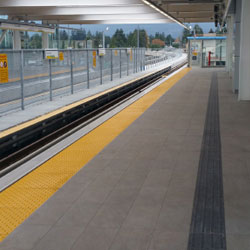









Accessibility is a fundamental human right that allows people with disabilities to participate fully in society. In Canada, various laws and regulations at the federal, provincial, and municipal levels aim to make public and private spaces accessible.
For those involved in construction, renovation, or facility management, understanding the critical accessibility codes is crucial to ensure compliance. When it comes to tactile warning systems that assist the visually impaired, some essential standards and regulations apply across Canada. Let’s explore the most important ones.
The Accessibility for Ontarians with Disabilities Act (AODA) is a landmark provincial legislation passed in 2005. Its goal is to make Ontario fully accessible for people with disabilities by 2025.
AODA standards set accessibility requirements in 5 key areas:
The Design of Public Spaces standard directly relates to tactile warning systems. It covers technical specifications for public spaces like:
For contractors, the AODA Design of Public Spaces standard legally mandates installing compliant tactile warning systems in indoor and outdoor public spaces. This makes AODA the foremost accessibility regulation in Ontario to consult for tactile projects.
The CSA Group develops standards incorporated into Canada’s National Building Code (NBC). When it comes to tactile warnings, CSA B651 is the authority.
This comprehensive standard specifies the technical requirements for tactile walking surface indicators (TWSIs). It provides guidelines on:
CSA B651 is aligned with global standards like ISO 23599 on tactile walking surfaces. By adhering to CSA B651, contractors can be assured that their tactile installations will meet strict dimensional, durability, visual contrast, and placement regulations.
Canada’s National Building Code (NBC) sets out technical provisions for constructing new buildings and renovations. It references vital accessibility requirements from CSA standards on tactile warning surfaces.
The NBC demands a minimum level of accessibility in all new construction and renovations through features like:
Meeting NBC requirements necessitates installing compliant tactile warning systems at specific locations. Being the national benchmark, the NBC is a crucial code for tactile installations.
Alongside the national standards, provincial and municipal building codes contain additional accessibility rules tailored to local needs.
For example, Ontario’s Building Code specifies supplementary requirements for new construction and renovations in the province. It adopts the NBC’s accessibility provisions and CSA tactile surface standards.
Municipalities like Toronto also issue their building code requirements and facility access standards. These local codes should be cross-checked to ensure complete compliance.
The IFC contains provisions related to fire safety in new and existing buildings. Section 1024 on Luminous Egress Path Markings mandates photoluminescent markings to delineate exit paths in many occupancy types.
Photoluminescent wayfinding strips, stair nosings, handrails, and door exit signs aid safe evacuation during fire emergencies by remaining illuminated even when lighting fails. IFC-compliant photoluminescent tactile systems can be crucial to creating a compliant facility per the code’s life safety objectives.
The Barrier-Free Design Standards issued by Public Services and Procurement Canada apply to federal buildings like post offices, border crossings, etc. These standards align with CSA requirements and provide schematics, drawings, and specifications related to accessibility.
Tactile warning strip standards are provided for stairs, pedestrian crossings, platform edges, etc. Adherence to these federal standards is mandatory for construction and renovations initiated by Public Services and Procurement Canada.
As Canada’s premier accessibility solutions provider, Tactile Solution Canada partners with architects, contractors, and facility managers to integrate compliant tactile systems in projects across sectors. Our product portfolio includes trusted solutions like:
These industry-leading solutions are:
By consulting us early in your project, we can recommend optimal tactile solutions to fulfill Canadian accessibility regulations and protect from risks of non-compliance.
The primary federal, provincial, and local accessibility laws are provincial building codes, CSA standards, municipal bylaws, and the National Building Code of Canada.
Key areas are transit platforms, curb ramps, building entrances, commercial washrooms, stairs, pedestrian crossings, and parking areas.
Durable metal, engineered polymer, and porcelain tactile suit heavy-duty exterior use.
High-caliber tactile warning systems require minimal maintenance beyond inspecting for damage and replacing individual damaged sections as needed.
Let Tactile Solution Canada be your partner in creating safely accessible commercial, institutional, and public environments. Get in touch with our experts to learn more about equipping your next project with code-compliant tactile warning systems specially tailored to your needs.
